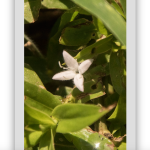The difference in buttonweed
Published 5:00 am Saturday, August 3, 2019


It’s been so hot that my hikes have been reduced to half-hearted slogs up and down the back roads near my farm. No enthusiasm and no expectation of finding anything of interest.
And so several weeks ago, as I was trudging along staring at my feet, I noticed some Virginia buttonweed (Diodia virginiana), followed by a new plant that looked remarkably like the buttonweed. A little research after my walk revealed that the mystery plant was, indeed, another buttonweed, common buttonwood (D. teres).
There are three species of Diodia in Virginia – the two natives that I found yesterday morning and then an introduced species, rough buttonweed (D. radula) that’s only been found on chrome ore piles in Newport News.
Common buttonweed is also known as poor Joe and poverty weed because it tends to grow in such poor, disturbed soil. It’s a summer annual with stems that can be either erect or sprawling; they are mostly unbranched and have pairs of opposite, toothless, lanceolate leaves. The upper surface of the leaves is medium green, while the lower surface is slightly paler. The leaf bases are joined at the stem with greenish white stipules, which have bristles on the upper rim. The small pale lavender-whitish flowers appear singly or in small clusters in the axils of middle to upper leaves. Common buttonweed is found throughout Virginia and typically grows in dry open areas, such as open fields, roadsides, and even dunes.
Virginia buttonweed tends to sprawl or trail more than common buttonweed. The stems are often reddish. The leaves appear in opposite pairs and are joined at the base by stipules with bristles on the upper rim. The flowers are larger and showier than those of common buttonweed. They are white and hairy and appear either singly or in pairs. Virginia buttonweed is generally found in wet areas – ditches, along ponds, and in wet fields. It is common in the Coastal Plain, but infrequent in the Piedmont, and rare in the mountains.
Although both of these plants are natives, Virginia buttonweed, in particular, can be very problematic as it’s one of the most difficult broadleaf weeds to control when it invades a lawn. It grows rapidly in poorly drained areas and can even withstand mowing heights as low as half an inch, It sets thousands of seeds and has an extensive root system. What’s more, it can reproduce vegetatively as well as via seeds. Just one clipping left over from mowing can start a new colony. So beware — just because it’s a native, doesn’t automatically make it a good choice for the garden.
Here’s hoping for cooler days and the arrival of the cranefly orchids.
CYNTHIA WOOD is a master gardener who writes two columns for The Herald. Her email address is cynthia. crewe23930@gmail.com.







